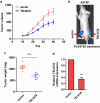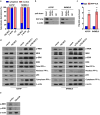Downregulation of lncRNA TSLNC8 promotes melanoma resistance to BRAF inhibitor PLX4720 through binding with PP1α to re-activate MAPK signaling
- PMID: 33389075
- PMCID: PMC11802067
- DOI: 10.1007/s00432-020-03484-4
Downregulation of lncRNA TSLNC8 promotes melanoma resistance to BRAF inhibitor PLX4720 through binding with PP1α to re-activate MAPK signaling
Abstract
Purpose: Approximately 60% of patients with melanoma harbor BRAF mutation and targeting BRAF offers enormous advance in the treatment of those patients. Unfortunately, the efficacy of the BRAF inhibitors is usually restricted by the onset of drug resistance. Therefore, better understanding of the adaptive drug resistance mechanisms is essential for the development of alternative therapeutic strategies, and offers more promising measures to promote the short duration of response to BRAF inhibitors.
Methods: The levels of tumor suppressive long noncoding RNA on chromosome 8p12 (TSLNC8) were evaluated by qPCR. The MTT assay, colony formation assay, apoptosis assay, and in vivo xenograft tumor model were performed to assess the functions of TSLNC8 on drug resistance. Western blotting, RNA pull-down, and RNA immunoprecipitation (RIP) assays were applied to investigate the mechanisms of TSLNC8 in melanoma.
Results: Herein, our findings demonstrate that TSLNC8 is significantly downregulated in BRAF inhibitor-resistant melanoma tissues and cells. Moreover, downregulation of TSLNC8 in BRAF inhibitor sensitive cells reduces the toxicity response to BRAF inhibitor PLX4720, and inhibits apoptosis of melanoma cells-treated with PLX4720. Further assay elucidates that TSLNC8 can bind with the catalytic subunit of protein phosphatase 1α (PP1α) to regulate its distribution, and Downregulation of TSLNC8 results in PP1α cytoplasmic accumulation, thus re-activating the MAPK signaling. Eventually, the overexpression of TSLNC8 in BRAF inhibitor PLX4720-resistant melanoma cells restores the sensitive to BRAF inhibitor.
Conclusion: Collectively, our research provides a compelling rationale for resistance to BRAF inhibitor in melanoma, and the patient might benefit from the combinatorial therapy of BRAF inhibitors and lncRNA TSLNC8.
Keywords: BRAF mutation; MAPK signaling; PP1α; TSLNC8.
Conflict of interest statement
The authors declare no competing interests of this study.
Figures






Similar articles
-
Protein phosphatase 6 activates NF-κB to confer sensitivity to MAPK pathway inhibitors in KRAS- and BRAF-mutant cancer cells.Sci Signal. 2024 May 14;17(836):eadd5073. doi: 10.1126/scisignal.add5073. Epub 2024 May 14. Sci Signal. 2024. PMID: 38743809 Free PMC article.
-
Resistance to BRAF inhibition in BRAF-mutant colon cancer can be overcome with PI3K inhibition or demethylating agents.Clin Cancer Res. 2013 Feb 1;19(3):657-67. doi: 10.1158/1078-0432.CCR-11-1446. Epub 2012 Dec 18. Clin Cancer Res. 2013. PMID: 23251002 Free PMC article.
-
Exploiting mitochondrial dysfunction to overcome BRAF inhibitor resistance in advanced melanoma: the role of disulfiram as a copper ionophore.Cell Death Dis. 2025 Jul 1;16(1):482. doi: 10.1038/s41419-025-07766-y. Cell Death Dis. 2025. PMID: 40592836 Free PMC article.
-
Mitogen-activated protein kinase (MEK) inhibitors to treat melanoma alone or in combination with other kinase inhibitors.Expert Opin Drug Metab Toxicol. 2018 Mar;14(3):317-330. doi: 10.1080/17425255.2018.1432593. Epub 2018 Jan 30. Expert Opin Drug Metab Toxicol. 2018. PMID: 29363351
-
Combination therapy of BRAF inhibitors for advanced melanoma with BRAF V600 mutation: a systematic review and meta-analysis.J Dermatolog Treat. 2018 May;29(3):314-321. doi: 10.1080/09546634.2017.1330530. Epub 2017 May 31. J Dermatolog Treat. 2018. PMID: 28504036
Cited by
-
Immune Checkpoint Inhibitors and RAS-ERK Pathway-Targeted Drugs as Combined Therapy for the Treatment of Melanoma.Biomolecules. 2022 Oct 26;12(11):1562. doi: 10.3390/biom12111562. Biomolecules. 2022. PMID: 36358912 Free PMC article. Review.
-
Diagnostic and therapeutic role of non-coding RNAs regulating programmed cell death in melanoma.Front Oncol. 2024 Dec 24;14:1476684. doi: 10.3389/fonc.2024.1476684. eCollection 2024. Front Oncol. 2024. PMID: 39777348 Free PMC article. Review.
-
The Role of Non-coding RNAs in Tumorigenesis, Diagnosis/Prognosis, and Therapeutic Strategies for Cutaneous Melanoma.Methods Mol Biol. 2025;2883:79-107. doi: 10.1007/978-1-0716-4290-0_4. Methods Mol Biol. 2025. PMID: 39702705 Review.
-
Non-coding RNAs in BRAF-mutant melanoma: targets, indicators, and therapeutic potential.Naunyn Schmiedebergs Arch Pharmacol. 2025 Jan;398(1):297-317. doi: 10.1007/s00210-024-03366-3. Epub 2024 Aug 21. Naunyn Schmiedebergs Arch Pharmacol. 2025. PMID: 39167168 Review.
-
Novel Biological Strategies for Melanoma Therapy: A Focus on lncRNAs and Their Targeting.Cancers (Basel). 2025 Apr 9;17(8):1273. doi: 10.3390/cancers17081273. Cancers (Basel). 2025. PMID: 40282449 Free PMC article. Review.
References
-
- Ascierto PA et al (2013) Phase II trial (BREAK-2) of the BRAF inhibitor dabrafenib (GSK2118436) in patients with metastatic melanoma Journal of clinical oncology. Off J Am Soc Clin Oncol 31:3205–3211. 10.1200/JCO.2013.49.8691 - PubMed
-
- Chen D, Yu X (2018) Long noncoding RNA TSLNC8 suppresses cell proliferation and metastasis and promotes cell apoptosis in human glioma. Mol Med Rep 18:5536–5544. 10.3892/mmr.2018.9609 - PubMed
MeSH terms
Substances
LinkOut - more resources
Full Text Sources
Other Literature Sources
Medical
Research Materials
Miscellaneous

